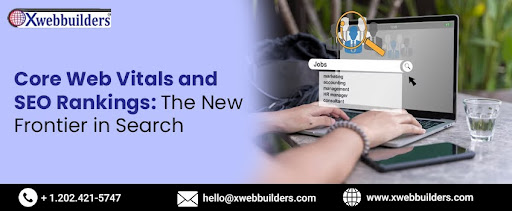
July 04, 2025

The world of SEO (Search Engine Optimization) is in a constant state of flux, with search engines continually updating their algorithms to provide users with the best possible online experience. In recent times, a significant shift has occurred with the introduction of Core Web Vitals, a set of user-centered metrics that gauge the performance, interactivity, and visual stability of web pages. In this blog, our Search Engine Optimization Services in Ashburn USA, we will dive deep into the realm of Core Web Vitals, exploring what they are, why they matter, and how they impact SEO rankings.
Core Web Vitals comprise a subset of Web Vitals, a larger initiative by Google to provide unified guidance for quality signals that are essential for delivering a great user experience on the web. These three core metrics focus on the critical aspects of user experience:
- Largest Contentful Paint (LCP): Measures loading performance. It marks the point in the page load timeline when the main content becomes visible to the user.
- First Input Delay (FID): Measures interactivity. It quantifies the responsiveness of a web page when users first try to interact with it.
- Cumulative Layout Shift (CLS): Measures visual stability. It quantifies how often users experience unexpected layout shifts that are visible and disruptive.
In the ever-evolving realm of search engine optimization (SEO), staying ahead of the curve is crucial. Core Web Vitals have emerged as a defining factor in SEO rankings, and understanding why they matter is essential for anyone looking to succeed in the digital landscape.
1) User-Centric Focus: Core Web Vitals place the user front and center. They assess the overall user experience of a website, considering factors like page loading speed, interactivity, and visual stability. In essence, they reflect how real users perceive and interact with a site. Prioritizing Core Web Vitals ensures that your website is designed for the best possible user experience.
2) Rankings and Visibility: Google, the leading search engine, has incorporated Core Web Vitals into its ranking algorithm. Websites that excel in these vital areas are more likely to rank higher in search results. This shift signifies Google's commitment to rewarding websites that prioritize user experience, ultimately benefiting users by directing them to websites that are faster and more reliable.
3) Reduced Bounce Rates: Slow-loading pages and a poor user experience often result in high bounce rates. Visitors are more likely to abandon a website that takes too long to load or frustrates them with layout shifts. By optimizing Core Web Vitals, you can significantly reduce bounce rates, ensuring that visitors stay longer on your site and engage more with your content.
4) Improved Conversion Rates: A positive user experience translates into improved conversion rates. Whether your goal is to sell products, capture leads, or encourage specific actions on your site, a fast-loading, responsive website with excellent interactivity fosters trust and encourages users to take the desired actions.
5) Mobile Friendliness: As mobile device usage continues to rise, providing a seamless experience on smartphones and tablets is crucial. Core Web Vitals emphasize mobile-friendliness, making it imperative for websites to cater to this growing user base effectively.
6) Competitive Advantage: Websites that embrace Core Web Vitals gain a competitive edge. Not only do they perform better in search rankings, but they also stand out as reliable and user-friendly options among competitors that may not have optimized these key aspects of their web presence.
Google introduced Core Web Vitals as a ranking factor in its algorithm. This means that websites optimized for these vitals are more likely to rank higher in search results. Here's why Core Web Vitals have such a significant impact on SEO rankings:
1) User-Centric Approach: Google's primary goal is to provide users with the best possible search experience. Core Web Vitals directly align with this objective by focusing on aspects that enhance user experience. Google rewards websites that prioritize their users.
2) Reduced Bounce Rates: Slow-loading pages, unresponsive interfaces, and shifting layouts frustrate users and increase bounce rates. Websites optimized for Core Web Vitals are faster, more interactive, and visually stable, resulting in lower bounce rates.
3) Improved Engagement: Websites that offer a seamless and responsive experience tend to engage users better. When users can access and interact with content without hindrance, they are more likely to stay on the site longer, explore more pages, and engage with the content.
4) Mobile Friendliness: With the growing prevalence of mobile device usage, mobile-friendliness is crucial. Core Web Vitals emphasize mobile performance, making it imperative for websites to deliver a top-tier mobile experience, which, in turn, positively impacts SEO rankings.
5) Competitive Advantage: Websites that optimize for Core Web Vitals gain a competitive edge. Not only do they rank higher in search results, but they also stand out as reliable, user-friendly options in their respective niches.
In the ever-evolving realm of SEO, adapting to the latest trends and algorithms is key to maintaining high search engine rankings. One such crucial development is Google's Core Web Vitals, a set of user experience metrics that can significantly impact your website's SEO rankings. Optimizing for Core Web Vitals isn't just about SEO; it's about enhancing user satisfaction and engagement. Here's how to optimize for these vital metrics.
1) Largest Contentful Paint (LCP): LCP measures loading performance. To improve it, focus on optimizing images and ensuring swift server response times. Compress images, use modern formats, and consider a reliable content delivery network (CDN).
2) First Input Delay (FID): FID evaluates responsiveness. Optimize JavaScript by eliminating unnecessary scripts and leveraging asynchronous loading. Reducing main thread work is also crucial.
3) Cumulative Layout Shift (CLS): CLS examines visual stability. Specify dimensions for media elements, prevent ads from unexpectedly shifting content, and implement lazy loading for images and videos.
4) Mobile Optimization: Given Google's mobile-first indexing, prioritize mobile optimization. Ensure that your website offers a seamless experience on various mobile devices.
5) Content Delivery: Opt for a content management system (CMS) and web hosting that align with Core Web Vitals. Regularly monitor and fine-tune your website's performance using diagnostic tools.
The future of SEO is an exciting frontier, characterized by dynamic shifts and continuous evolution. As we navigate through the digital landscape, one thing is abundantly clear: SEO is far from static. With the advent of Core Web Vitals, we find ourselves at the forefront of a new era in search engine optimization.
As AI and machine learning continue to advance, we can anticipate even more sophisticated algorithms that decipher user intent and context with remarkable precision. Semantic SEO, as discussed earlier, will play a pivotal role in this transformation. It's not just about matching keywords; it's about understanding the intricacies of user queries and providing content that genuinely fulfills their needs.
In this ever-evolving landscape, SEO professionals must remain adaptable, ready to embrace new technologies and strategies. The future of SEO is not about quick fixes but sustainable, user-centric practices. It's about providing valuable content, ensuring seamless user experiences, and staying ahead of the curve with emerging trends and technologies. As Core Web Vitals lead the way, the future of SEO promises to be an exciting journey into uncharted territories of digital marketing.
Core Web Vitals represent a seismic shift in SEO, signaling Google's commitment to prioritizing user experience. In a world where websites compete fiercely for users' attention, understanding and optimizing for these vital metrics is no longer optional—it's essential for success in the digital realm. By embracing Core Web Vitals, webmasters and SEO professionals can secure their websites' positions at the top of search engine rankings while delivering exceptional experiences to their users. For more information or to avail SEO Services in Ashburn USA, visit Xwebbuilders.com .